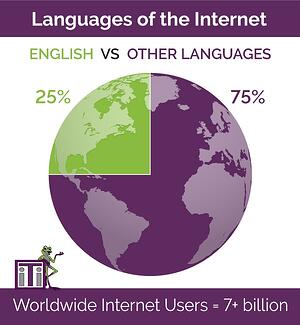We recently published an article on how the benefits of exporting include an increase in market share and profits for manufacturers looking to build upon domestic success.
We briefly discussed best practices when it comes to an international marketing strategy and today we are going to expand!
The Importance of a Digital Strategy
Do you find yourself neglecting your online presence because you just don’t see the value in it for your industry? It is time to rethink that mindset.
Common Sense Advisory (CSA) reports that “Companies that are in favor of technology grow nearly three times as fast as companies that have mixed feelings about it or are against it.”
If your expansion strategy includes exporting then you have no choice but to invest in your website and marketing materials if you want to be truly successful.
After all, how are you supposed to start doing business in any market, let alone a foreign country, if no one can even find you?
 While English is the dominant online language, it still only accounts for 25% of total internet users! That means if you are marketing in English alone, you are alienating 75% of the 7+ billion total internet users.
While English is the dominant online language, it still only accounts for 25% of total internet users! That means if you are marketing in English alone, you are alienating 75% of the 7+ billion total internet users.
Emerging markets have increasing buying power and you are leaving a lot of money on the table if you don’t speak to them in their language.
Click here for more details on the top languages used on the internet
Your website is often times a customers first impression of your company and you know how the old saying goes, “you don’t get a second chance to make a first impression”. So, you better make a good impact.
You may be wondering where to start and that’s where we come in.
Below are 14 considerations when preparing your marketing to go global!

1. All marketing must be local
Any company with markets that cross country or cultural borders must literally speak the language of the people in each market. Your company may have the best product in Europe but that’s not enough to assure sales in Canada or elsewhere.
Your marketing materials – your words, images, colors and designs – must relate easily and clearly to the people across national and cultural borders.
Common Sense Advisory (CSA) recently polled 3,000 consumers in 10 countries in their languages to test whether companies can increase their market share and sales by localizing products and websites.
The research found that more local language content throughout the customer experience leads to a greater likelihood of purchase.
2. No single country dominates the global market
Today no one country accounts for more than 22% of the world economy. As time goes on and emerging markets continue to grow, that percentage is bound to decrease. Online marketing’s the same.
Last year, Common Sense Advisory research showed the United States as the largest online market at 25%. But that percentage will decrease as other markets grow their economies and there is speculation that other languages will soon out rank English as more emerging economies become active online.

3. Use the best but sometimes overlooked communication tools
Marketers often talk about today’s world being a visual world. That’s true in many ways. To market and sell you must provide more than great images, video and design.
These marketing assets shouldn’t be overlooked in your international strategy! They may also require alterations based on your new market. We’ll discuss localization later in the article.
And don’t forget one of the best marketing and communication tools – words. Yes, the glamour of great design can dazzle, but you need strong worded messages to market and sell.
In the 21st century, marketers can now display words in more ways than ever including public relations campaigns, advertising, print and electronic brochures, websites, text messages, e-mail campaigns, social media sites, smartphone apps and others.
There is an common saying in the language services industry, “garbage in, garbage out”. If the written English copy is sub-par then the translation will not be any better.
Translators can’t improve upon the source text, they can only do their best to accurately convey the source into a second language.
Make sure you’re English copy is stellar and the translation will be as well. Read on for more tips on how to write in a manner that will, quite literally, translate well into other languages.

4. Consider outsourcing your international marketing needs
When you’re reaching out to a market with a different language or culture it’s can be best to outsource your marketing communications. Outsourcing allows you to continue to do what you do best – produce your products and services.
Outsourcing also allows you to hire marketers who specialize in international marketing with a deep knowledge of the language and customs of the people in the markets you want to enter.
There are many strategies for exporting and international marketing & it mostly depends on how much you want to invest of your time and energy. Sometimes outsourcing will be best but some businesses also prefer to keep marketing activities in-house.
Whichever direction you choose, do so strategically and bring in expert consultants to support you in unfamiliar territory.
5. Marketing materials must be clear, natural and easy in every language
Your translated marketing communications must come across as clear and natural. Just because the language is new to your company doesn’t give you any extra room for error.
Professional translators who live or have lived in that market and intimately know the culture will deliver higher quality work than translators who are new to the market. It’s not just about getting the words right. It’s about getting the ideas and the feelings behind those words right.
Another important thing to take into consideration is the use of colors, fonts, and photos. These are a big part of the localization process which goes beyond translation.
Click here for more details on how to take your website global through localization
6. Recognize the dangers of global communication
Marketing professionals in global companies are in a dangerous position. Today it’s commonplace for anyone, virtually anywhere in the world, to communicate effortlessly and within seconds with anyone else.
For the most part, geographical distances have been eliminated. But it’s not always a good idea to take advantage of the speed and spread of today’s instant communication.
The most successful global companies take the time to communicate well or they don’t communicate at all. If you want to represent your company well or successfully market a product or service, you first must be sure you use language that will connect well with the intended market. Neglecting, ignoring or not knowing the customs and culture of the market is a danger.

7. Hire a language services company that asks good questions
Because it can be complicated and risky to work with individual translators (especially when working across multiple languages!), contract with a language services or translation agency.
Don’t base your decision on price alone. Find a company who knows not just the language but also the customs and culture of the market you want to enter.
A translation agency will consult with clients in order to choose the right translator to work on each of your projects (including editors and proofreaders). Going with a company versus an individual translator will save you time because a company will do the leg work involved in choosing the best people for your needs.
8. It’s better to not communicate than to communication poorly
Poor communication can be worse than no communication. Poor communication can not only send the wrong message today but also send a long-lasting message that the company doesn’t care to understand the market’s culture or language. One poor message may cause people in a market to not read the next five or 10 or more messages from the same company.
9. Recognize that English as a global marketing language is on a decline
Common Sense Advisory (CSA) says the value of English as the preferred global language is on an extended, historical decline.
It’s the non-English world that’s coming online the fastest. Economic growth is and will continue to be higher in emerging non-English markets like India, Vietnam, Brazil, Russia and many others.
10. Write short and simple sentences
Keeping marketing materials concise is great for your current customers, and it makes it much easier for translators to do their job.
Long sentences are one of the most common problems in marketing content authored by companies.. Keep in mind the reading levels of your target demographics and be sure to communicate that with your translation company.
The Importance of Website Localization In a Global Marketplace
11. Avoid famous phrases from one culture that may not make sense in another culture
In the United States English-speaking market there’s a phrase from a famous TV and movie series (Star Trek) that nearly everyone understands: “To boldly go where no man has gone before.”
Marketing communications in U.S. English can safely use this phrase. All others should avoid it. Translating that phrase’s meaning may sound confusing and make little sense in other languages. This is an important piece of the localization puzzle to keep in mind!

12. Avoid idiomatic expressions
Idiomatic expressions are a type of informal English that have a meaning different from the meaning of the words in the expression.
For example, the idiomatic expression, “hit it out of the ballpark” doesn’t mean you’re going to physically hit something out of a stadium. It means you’ll be successful.
When your marketing materials are translated from English, you might need to avoid expressions like “bat an eyelid” and “when pigs fly”.
When translated word-for-word these phrases don’t carry the same meaning in any other language. Before passing your marketing materials to a translator check your content for idiomatic expressions. Try replacing any you find with something more universally understood.
13. Be careful with words like “this” and “that”
If your marketing material says, “This will save you $500!” or “That resulted in a better night’s sleep” you’re making translation harder than it needs to be.
In English these sentences sound fine, but the words “this” and “that” set up translation barriers. Many languages use masculine and feminine forms of nouns, so without the nouns in these sentences you leave the translator with nothing to work with. Instead write, “This solution will save you $500” or “This product will save you $500.”
14. International marketing requires more than just translation
Localization means to translate not just the marketing words but the imagery, layout, colors and more to fit the new market’s cultural norms and expectations.
Writing for Social Media Explorer, Adam Helweh used the example of Lush Cosmetics . Lush tackled the localization issue by developing separate websites for each country.
Rather than send business prospects to the same website, this cosmetic company presents them with 45 national flags with the country’s name next to the flag. Countries from Australia to Latvia; Japan to United Arab Emirates are represented. Each flag leads to a completely different website.
(There has been a debate in recent years on whether or not it’s proper to use flags. You see, many languages are spoken across multiple countries. It can be alienating to some who see a different flag representing their language. That’s a topic for another day though…)
Looking for inspiration? Here’s 3 Global Companies With Killer Localized Websites
Certainly there are more guidelines for international marketing that will be effective in a new language. What other creative ways have you seen? What’s your best advice on connecting with a market with a different culture or language?
If you’re ready to take your website to the next level, be sure to download our free questionnaire!






Comments are closed here.